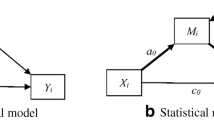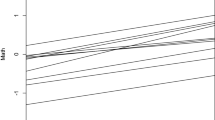Abstract
Previous research has examined moderation effects with traditional analyses such as ANOVA, ANCOVA, moderated regression analysis (MRA), or a combination of MRA and subgroup analysis. However, there exists some confusion in such analyses, because the analyses do not separately consider two possible effects of a moderator on the form and strength of relationship between a focal predictor and a dependent variable. The effect on the form is measured with the interaction effect between the focal predictor and the moderator whereas the effect on the strength is measured with the effect of the moderator on predictability of the focal predictor on the dependent variable. This paper proposes a heterogeneous MRA that allows the moderation effect to be heterogeneous in the population, and shows that it allows one to examine the two possible moderation effects separately. Furthermore, this paper shows that previous research based on the traditional analyses might have incorrectly led to conclusions that there did not exist moderation effects even though the moderation effects were strongly supported by theories. The heterogeneous MRA can examine moderation effects with a data set collected for the traditional analyses. Thus, this paper recommends one to use the heterogeneous MRA together with the traditional analyses.

Similar content being viewed by others
References
Aguinis, H., Beaty, J.C., Boik, R.J., Pierce, C.A.: Effect size and power in assessing moderating effects of categorical variables using multiple regression: A 30-year review. J. Appl. Psychol. 90, 94–107 (2005)
Aguinis, H., Edwards, J.R., Bradley, K.J.: Improving our understanding of moderation and mediation in strategic management research. Organ. Res. Methods 20, 665–685 (2017)
Allison, D.B., Heshka, S., Pierson, R.N., Jr., Wang, J., Heymsfield, S.B.: The analysis and identification of homologizer/moderator variables when the moderator is continuous: An illustration with anthropometric data. Am. J. Hum. Biol. 4, 775–782 (1992)
Arnold, H.J.: Moderator variables: A Clarification of conceptual, analytic and psychometric issues. Organ. Behav. Hum. Perform. 29, 143–174 (1982)
Brambor, T., Clark, W.R., Matthew, G.: Understanding interaction models: Improving empirical analysis. Polit. Anal. 14, 63–82 (2006)
Breusch, T.S., Pagan, A.R.: A simple test for heteroscedasticity and random coefficient variation. Econometrica 47, 1287–1294 (1979)
Cohen, J., Cohen, P.: Applied multiple regression/correlation analysis for the behavioral sciences. Lawrence Erlbaum Associates, Hillsdale, N.J. (1975)
Dawson, J.F.: Moderation in management research: What, why, when, and how. J. Bus. Psychol. 29, 1–19 (2014)
Friedrich, R.J.: In defense of multiplicative terms in multiple regression equations. Am. J. Polit. Sci. 26, 797–833 (1982)
Gardner, R.G., Harris, T.B., Li, N., Kirkman, B.L., Mathieu, J.E.: Understanding “it depends” in organizational research: A theory-based taxonomy, review, and future research agenda concerning interactive and quadratic relationships. Organ. Res. Methods 20, 610–638 (2017)
Ghiselli, E.E.: Moderating effects and differential reliability and validity. J. Appl. Psychol. 47, 81–86 (1963)
Hayes, A.F.: Introduction to mediation, moderation, and conditional process analysis: A regression based approach. The Guilford Press, New York (2013)
Irwin, J.R., McClelland, G.H.: Misleading heuristics and moderated multiple regression models. J. Mark. Res. 38, 100–109 (2001)
Jaccard, J., Turrisi, R.: Interaction effects in multiple regression. Sage Publications, Thousand Oaks, CA (2003)
Johnson, C. D.: The population control variable or moderator variable in personnel research, In Tri-Service Conference on Selection Research. Washington, D. C.: Office of Naval Research, 125–134 (1960)
Kam, C. D., Franzese, R. J.: Modeling and interpreting interactive hypotheses in regression analysis, University of Michigan Press (2007)
Kmenta, J.: Elements of econometrics. Macmillan, New York (1971)
Leppink, J.: Analysis of covariance (ANCOVA) vs. moderated regression (MODREG): Why the interaction matters. Health Professions Education, 4, 225–232 (2018)
Moore, C. W., Petty, J. W., Palich, L. E., Longenecker, J. G.: Managing small business: An entrepreneurial emphasis. South-Western CENGAGE Learning, West Yorkshire (2008)
Prescott, J.E.: Environments as moderators of the relationship between strategy and performance. Acad. Manag. J. 29, 329–346 (1986)
Rencher, A. C., Schaalje, G. B.: Linear models in statistics. John Wiley & Sons (2008)
Sharma, S., Durand, R.M., Gur-Arie, O.: Identification and analysis of moderator variables. J. Mark. Res. 18, 291–300 (1981)
Shieh, G.: Detecting interaction effects in moderated multiple regression with continuous variables power and sample size considerations. Organ. Res. Methods 12, 510–528 (2009)
Smithson, M.: A simple statistic for comparing moderation of slopes and correlations. Front. Psychol. 3, 231 (2012)
Swart, M.P., Roodt, G.: Marketing segmentation variables as moderators in the prediction of business tourist retention. Serv. Bus. 9, 491–513 (2015)
Zedeck, S.: Problems with the use of moderator variables. Psychol. Bull. 76, 295–310 (1971)
Author information
Authors and Affiliations
Corresponding author
Additional information
Publisher's Note
Springer Nature remains neutral with regard to jurisdictional claims in published maps and institutional affiliations.
Appendices
Appendix 1
Equation 1 is equivalent to:
where \({x}_{F}\) indicates a specific value of \(X\). Simplifying Eq. 12 leads to:
where \({X}^{t}=X-{x}_{F}\), \({\alpha }^{t}=\alpha +{\beta }_{x}{x}_{F}\), and \({\beta }_{z}^{t}={\beta }_{z}+{\beta }_{xz}{x}_{F}\).
Thus, in Eq. 13, Z can be classified as the Pure Moderator if \({x}_{F}=-{\beta }_{z}/{\beta }_{xz}\) (implying \({\beta }_{z}^{t}=0\)) when \({\beta }_{xz}\ne 0\), whereas it can be classified as the Quasi-moderator if \({x}_{F}\ne -{\beta }_{z}/{\beta }_{xz}\) (implying \({\beta }_{z}^{t}\ne 0\)) when \({\beta }_{xz}\ne 0\).
Appendix 2
The variance of the error term in Eq. 6 is written as:
Thus, it is possible to replace unknown squared errors \({e}_{i}^{2}\) with \({\widehat{e}}_{i}^{2}={\left({Y}_{i}-{\widehat{Y}}_{i}\right)}^{2}\) where:
\({e}_{i}={Y}_{i}-\left(\alpha +{\beta }_{x}{X}_{i}+{\beta }_{z}{Z}_{i}+{\beta }_{xz}{X}_{i}{Z}_{i}\right)\) for i = 1, 2, ···, N, and then regress \({\widehat{e}}_{i}^{2}\) in Eq. 14, i.e.:
where \({\sigma }^{2}\ge 0\) and \({\tau }_{xz}^{2}\ge 0\), of which the coefficients (\({\sigma }^{2}\) and \({\tau }_{xz}^{2}\)) can be estimated by non-negative least squares. Eq. 15 is the auxiliary model of the HMRM, which is used to probe whether the error term satisfies the assumption of homoscedasticity in Breusch-Pagan test (Breusch and Pagan 1979).
If \({\widehat{\tau }}_{xz}^{2}=0\) in the recovered regression model, one can conclude that the third variable (Z) is Non-Homologizer because the variance of the error term does not depend on levels of Z. If \({\widehat{\tau }}_{xz}^{2}\ne 0\) in the recovered regression model, one can conclude that the third variable is Homologizer.
Appendix 3
With the estimates in Eq. 15, one can calculate the weight used in the WHMRM, which is written as:
Then, one can estimate the WHMRM written as:
where \({Y}_{i}^{t}={Y}_{i}^{t}/\sqrt{{\widehat{W}}_{i}}\), \({H}_{i}=1/\sqrt{{\widehat{W}}_{i}}\), \({X}_{i}^{t}={X}_{i}/\sqrt{{\widehat{W}}_{i}}\), \({Z}_{i}^{t}={Z}_{i}/\sqrt{{\widehat{W}}_{i}}\), \({X}_{i}^{t}{Z}_{i}^{t}={X}_{i}{Z}_{i}/\sqrt{{\widehat{W}}_{i}}\) and \({e}_{i}^{t}={e}_{i}/\sqrt{{\widehat{W}}_{i}}\).
The WHMRM satisfies the assumption of homoscedasticity.
Rights and permissions
About this article
Cite this article
Park, SJ., Yi, Y. Assessing moderation effects with a heterogeneous moderated regression analysis. Qual Quant 57, 701–719 (2023). https://doi.org/10.1007/s11135-022-01383-z
Accepted:
Published:
Issue Date:
DOI: https://doi.org/10.1007/s11135-022-01383-z




